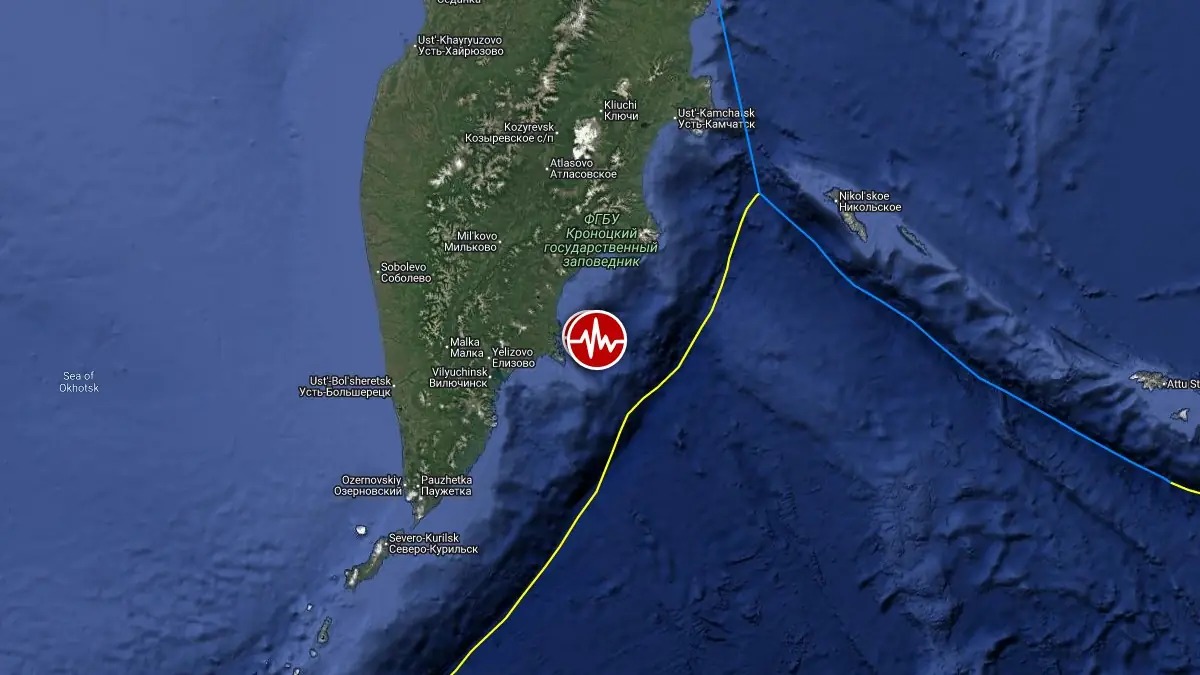Table of Contents
The Kamchatka Peninsula in Russia witnessed a powerful series of earthquakes in July 2025, shaking the seismically active region and drawing global attention. The most intense quake recorded was of 7.4 magnitude on July 20, followed by a 6.8 magnitude tremor on July 22, raising fears of further aftershocks.
This article explores the scientific causes, historical context, geographical relevance, and global significance of these seismic events. It is crucial for aspirants of UPSC, SSC, State PSCs, and those preparing for disaster management papers.
Kamchatka Earthquakes 2025
In July 2025, the remote and geologically volatile Kamchatka Peninsula in Russia was hit by a series of strong earthquakes, alarming both local authorities and global geological communities. The strongest earthquake struck on July 20, 2025, with a magnitude of 7.4, followed by another powerful 6.8 magnitude earthquake on July 22, 2025. These seismic events occurred near the eastern coast, along the dangerous Kuril-Kamchatka subduction zone, part of the Pacific Ring of Fire.
| Feature | Details |
|---|---|
| Dates | July 20 and July 22, 2025 |
| Magnitudes | 7.4 (July 20), 6.8 (July 22) |
| Depths | 20 km (7.4M), 59 km (6.8M) |
| Epicenter | Near Petropavlovsk-Kamchatsky |
| Plate Boundary | Pacific Plate and North American Plate |
| Tsunami Warning | Issued then cancelled (no waves found) |
| Reporting Agencies | USGS, NCM UAE, PTWC |
What Caused the Kamchatka Earthquakes 2025?
The Kamchatka Peninsula is situated at the tectonic boundary between the Pacific Plate and the North American Plate. This subduction zone — where the Pacific Plate moves beneath the North American Plate — generates intense geological stresses leading to frequent earthquakes and volcanic activity.
-
The 7.4 magnitude quake on July 20, 2025, was caused by reverse faulting along the subduction zone interface.
-
The Pacific Plate moves at an average rate of 77 mm per year relative to the North American Plate.
-
The July 22 quake of 6.8 magnitude struck at a deeper level (59 km), indicating ongoing tectonic adjustments following the initial major event.
Timeline of Earthquake Events
| Date | Magnitude | Depth | Remarks |
|---|---|---|---|
| July 20, 2025 | 7.4 | 20 km | Major earthquake, tsunami alert issued |
| July 22, 2025 | 6.8 | 59 km | Fourth earthquake in recent sequence |
| Prior Events | M6.4, M6+ | Various | Seismic swarms observed days earlier |
The National Centre of Meteorology (UAE) and the Pacific Tsunami Warning Centre (PTWC) tracked and confirmed the seismic activity. Though tsunami warnings were issued, they were later withdrawn after no waves were recorded.
Historical Context: Seismic Activity in Kamchatka
Kamchatka is no stranger to powerful earthquakes:
-
The 1952 Kamchatka earthquake was a massive 9.0 magnitude event that generated tsunami waves reaching as far as Hawaii.
-
Since 1900, Kamchatka has witnessed at least seven earthquakes of magnitude 8.3 or greater.
-
The region hosts 127 volcanoes, with 22 classified as active, linking seismic and volcanic hazards closely.
Impact of the 2025 Earthquakes
-
Tsunami warnings were issued following the July 20 quake but were later cancelled as no tsunami waves were detected.
-
Fortunately, there were no reports of casualties or major structural damage.
-
Authorities continue to monitor the situation closely due to the risk of aftershocks.
Geography and Climate of Kamchatka
-
The peninsula stretches approximately 1,200 kilometers long and 480 kilometers wide, flanked by the Sea of Okhotsk to the west and the Pacific Ocean to the east.
-
It features two major mountain ranges and several rivers, including the significant Kamchatka River.
-
The climate is subarctic, with cold, snowy winters and short, cool summers.
-
Vegetation varies from tundra mosses to dense birch and larch forests in protected valleys.
Human and Economic Significance
-
Petropavlovsk-Kamchatsky is the main urban center, serving as a port and administrative hub.
-
The local population comprises ethnic Russians and indigenous peoples such as the Koryak and Chukchi.
-
The economy largely depends on fishing, notably crab harvesting, alongside limited agriculture and some livestock herding.
-
Geothermal energy exploitation is emerging in the region due to its volcanic activity.
Lessons for Disaster Preparedness and Global Monitoring
-
Kamchatka’s 2025 earthquakes highlight the importance of early warning systems, earthquake-resistant infrastructure, and public awareness in seismic zones.
-
International cooperation, such as monitoring by the US Geological Survey (USGS) and the National Centre of Meteorology, UAE, plays a crucial role in timely alerts.
-
Countries near the Pacific Rim can learn from Kamchatka’s preparedness strategies to mitigate risks posed by similar subduction zone earthquakes.
Conclusion
The Kamchatka Earthquakes of 2025 reaffirm the peninsula’s position as a critical seismic hotspot within the Pacific Ring of Fire. These events provide essential data for scientists and policymakers to enhance earthquake preparedness and disaster response strategies. Understanding Kamchatka’s unique tectonic setting also helps build broader awareness of natural hazards affecting similar regions globally.


 UNEP Champions of the Earth Award: UN's ...
UNEP Champions of the Earth Award: UN's ...
 Shilp Didi Programme: Empowering Women A...
Shilp Didi Programme: Empowering Women A...
 Is the Falling Rupee a Cause for Alarm?
Is the Falling Rupee a Cause for Alarm?

























